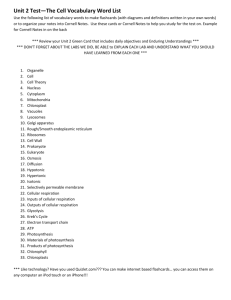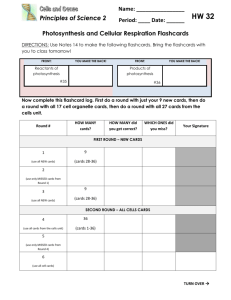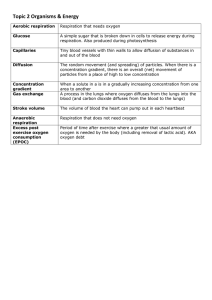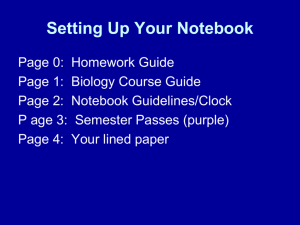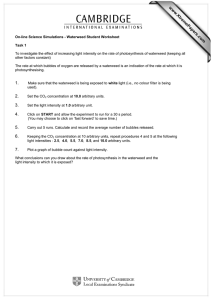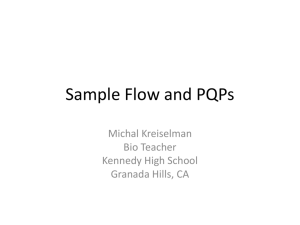Syllabus - Science Pioneers
advertisement
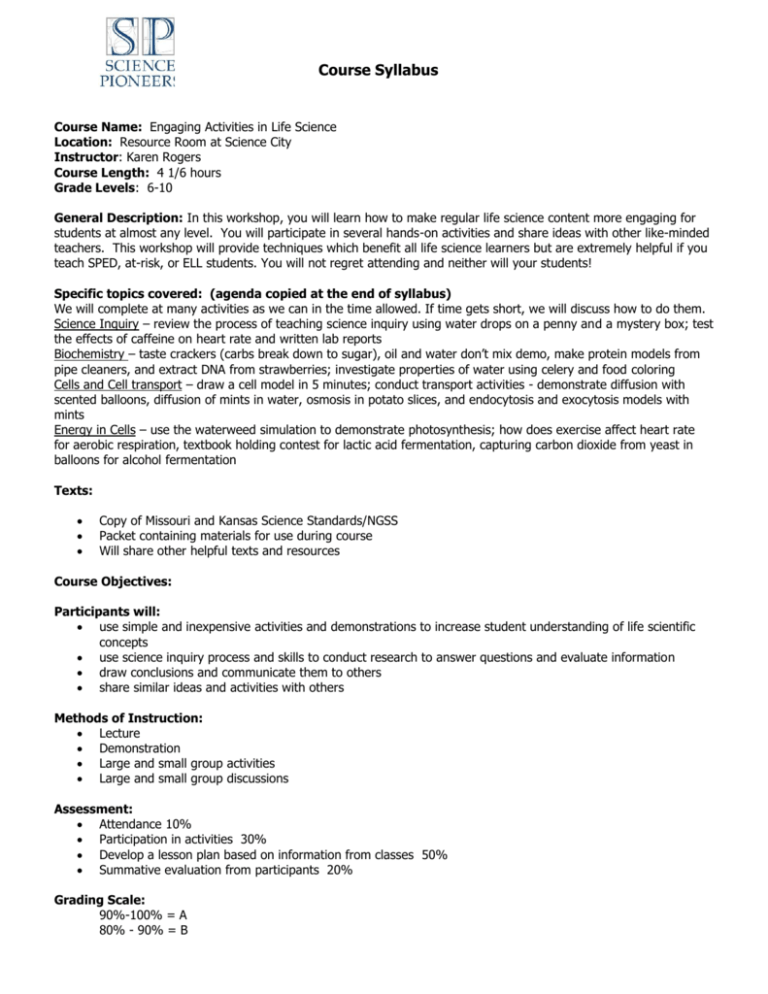
Course Syllabus Course Name: Engaging Activities in Life Science Location: Resource Room at Science City Instructor: Karen Rogers Course Length: 4 1/6 hours Grade Levels: 6-10 General Description: In this workshop, you will learn how to make regular life science content more engaging for students at almost any level. You will participate in several hands-on activities and share ideas with other like-minded teachers. This workshop will provide techniques which benefit all life science learners but are extremely helpful if you teach SPED, at-risk, or ELL students. You will not regret attending and neither will your students! Specific topics covered: (agenda copied at the end of syllabus) We will complete at many activities as we can in the time allowed. If time gets short, we will discuss how to do them. Science Inquiry – review the process of teaching science inquiry using water drops on a penny and a mystery box; test the effects of caffeine on heart rate and written lab reports Biochemistry – taste crackers (carbs break down to sugar), oil and water don’t mix demo, make protein models from pipe cleaners, and extract DNA from strawberries; investigate properties of water using celery and food coloring Cells and Cell transport – draw a cell model in 5 minutes; conduct transport activities - demonstrate diffusion with scented balloons, diffusion of mints in water, osmosis in potato slices, and endocytosis and exocytosis models with mints Energy in Cells – use the waterweed simulation to demonstrate photosynthesis; how does exercise affect heart rate for aerobic respiration, textbook holding contest for lactic acid fermentation, capturing carbon dioxide from yeast in balloons for alcohol fermentation Texts: Copy of Missouri and Kansas Science Standards/NGSS Packet containing materials for use during course Will share other helpful texts and resources Course Objectives: Participants will: use simple and inexpensive activities and demonstrations to increase student understanding of life scientific concepts use science inquiry process and skills to conduct research to answer questions and evaluate information draw conclusions and communicate them to others share similar ideas and activities with others Methods of Instruction: Lecture Demonstration Large and small group activities Large and small group discussions Assessment: Attendance 10% Participation in activities 30% Develop a lesson plan based on information from classes 50% Summative evaluation from participants 20% Grading Scale: 90%-100% = A 80% - 90% = B 70% - 80% = C 60% - 70% = D 59% and below = F Missouri and Kansas Standards Addressed: Kansas Standards use NGSS (DCI’s): HS-LS1 From Molecules to Organisms: Structures and Processes HS-LS1Develop and use a model to illustrate the hierarchical organization of interacting 2. systems that provide specific functions within multicellular organisms HS-LS15. Use a model to illustrate how photosynthesis transforms light energy into stored chemical energy HS-LS16. Construct and revise an explanation based on evidence for how carbon, hydrogen, and oxygen from sugar molecules may combine with other elements to form amino acids and/or other large carbon-based molecules. HS-LS17. Use a model to illustrate that cellular respiration is a chemical process whereby the bonds of food molecules and oxygen molecules are broken and the bonds in new compounds are formed resulting in a net transfer of energy. Missouri Science Standards (GLE’s): Strand 3: Characteristics and Interactions of Living Organisms 2. Living organisms carry out life processes in order to survive A. Cells are the fundamental units of structure and function of all living things B. Photosynthesis and cellular respiration are complementary processes necessary to the survival of most organisms on Earth. D. Cells carry out chemical transformations that use energy for the synthesis or breakdown of organic compounds E. Protein structure and function are coded by the DNA (Deoxyribonucleic acid) molecule. F. Cellular activities and responses can maintain stability internally while external conditions are changing (homeostasis). Engaging Activities in Life Science Agenda Ms. Karen E. Rogers 1. Introduction and Information a. Name tags, Introductions b. Information and Handouts 2. Activities (do, discuss, or demonstrate) Inquiry a. Water drops on a penny (variables, process, data, design, questions) b. Mystery box (observation vs. hypothesis) c. Caffeine on heart rate (reports, graphing, analysis) Biochemistry a. Properties of water (cohesion, adhesion, capillarity) b. Polymers (beads, cornstarch, sodium polyacrylate or diaper) c. Organic molecules Carbohydrates - crackers Lipids - water and oil don't mix Proteins - pipe cleaner model Nucleic acids - strawberry DNA Cells a. Structure/function – 5 minute diagrams (model) b. Transport 1) Membrane, diffusion (scented balloons, mint in water, osmosis in potatoes 2) Endocytosis/exocytosis with mints Energy a. Photosynthesis - waterweed simulation and chant b. Cellular respiration – aerobic – exercise on heart rate, anaerobic (alcohol, lactic acid) Demonstrate and/or discuss: Cell Division and Protein Synthesis a. Mitosis/Meiosis - noodle chromosomes, models/diagrams, flip books b. Making Protein - transcription/translation (DNA, mRNA, tRNA, amino acid) Genetics a. Trait activity (trait list, taste test papers) b. Baby lab Natural Selection a. Bean activity b. Newspaper moths Classification a. Worksheet/textbook - dichotomous key b. Classify objects - make your own key Virus and 5 Kingdoms of Life a. Virus - cell size chart, The Hot Zone (Preston), Ebola information b. Bacteria – where does bacteria exist c. Protozoa - microscope/color by ws d. Fungi - yeast, mushrooms, moldy food e. Plants - grow something (grass seed, fastplants), edible plant parts d. Animals - major phyla, organ dissection/anatomy (frog, rat) Ecology/Environmental Science a. Pollution on seed germination b. Water testing 3. Other Resources Books a. The First Days of School: How to Be an Effective Teacher (Wong) b. Life Science/Biology (100 Reproducible Activities) c. Biology for Every Kid (Van Cleave series) d. Biology Teacher's Survival Guide (Flemming) Websites a. Cellsalive.com - cells b. Froguts.com - online dissection c. Waterweed Simulation - photosynthesis d. Cell Size and Scale Miscellaneous a. Lab report rubric and write ups b. Kits (hands-on) 4. Conclusion a. Summary assignment, evaluation b. Thank you/dismiss :-)




